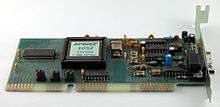ArVid


ArVid (Archiver on Video) (Russian: АрВид, Архиватор на Видео) is a data backup solution using a VHS tape as a storage medium. It was very popular in Russia and former USSR in mid-1990s.
It was produced in Zelenograd, Russia by PO KSI.[1]
Features
- Using low-cost VHS tapes and recording units for data backup.
- High reliability
- Hamming code error correction
- Easy data copying between two VHS units (eliminating need of a computer for data copying)
Disadvantages
- Inefficient tape capacity usage (only 2 grades of luminance signal spectrum were used)
- Poor software support
Operation
A VHS recorder unit should be connected to an ArVid ISA board via a composite video cable. Unit operation is controlled by a remote control emulator using an LED.
Device may operate in two modes: low data rate at 200 kbyte/s and high data rate at 325 kbyte/s (equivalent to roughly 1.33x and 2.17x CDR recording speed). The original, lower recording speed was retained as a user option because not all VHS recorders of the time offered sufficient recording quality to reliably support this higher speed.
An E-180 video tape is able to hold 2 GB of uncompressed data at the lower rate, more than sufficient for most PC hard drives of the time. This can be shown by calculating 200 KB x 60 x 60 x 3 = 2.06 GB (2.06 x 2^30 bytes), which also leaves a few minutes spare for header and synchronisation space.
Note that it is unclear here whether "200 kbyte" means 200,000 (200 x 10^3) or 204,800 (200 x 2^10); the above calculation assumes the latter, but the former still produces a capacity of 2.01 GB (2.01 x 2^30 bytes), providing 2.00 GB of capacity in a little under 2 hours and 59 minutes. Similarly, this means an E240 4-hour tape, using the higher data rate, would be capable of storing between 4.35 and 4.46 GB (2^30 bytes), approximately equivalent to a standard single-layer DVDR.
Models
- ArVid 1010 was first of ArVid devices. Its production started in 1992.
- ArVid 1020 was a successor to ArVid 1010 using more advanced integrated circuitry.
- ArVid 1030/1031 had better internal design, less power consumption, was less in size and was made using CPLD. It allowed automatic switching to a TV set when device was not in use.
- ArVid 1051/1052 introduced 325 kbyte/s data rate and 128/512 kbyte buffer cache (respectively).
References
- ↑ http://pc2008.ru/ustroistva-arhivacii-dannih-i-strimeri/arvid.php Arvid (Арвид), стример на базе видеомагнитофона VHS (Russian)
External links
| Wikimedia Commons has media related to ArVid. |
- "ArVid documentation" (in Russian). Archived from the original on 2005-02-07.
- ArVid description and images (in Russian)
- Drivers for linux and FreeBSD
- "Arvid FAQ". Archived from the original on 2013-03-19.